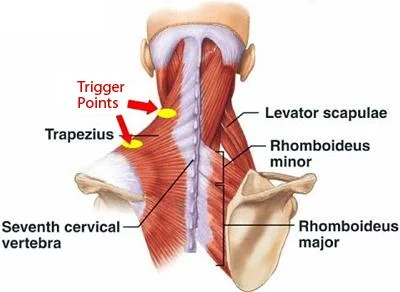This blog entry from a few years ago has been my most forwarded, commented on and asked about. I’m republishing it here for those that haven’t seen it, incase it’s helpful.
Have you ever found yourself begging a loved one for just five minutes of massage on a painful knot?
The kind that only seems to feel better when someone is rubbing it?
That's called a trigger point, and I thought I'd take a few minutes to explain what it is and why you get them.
The problem is essentially one of lactic acid. The same kind that makes your legs sore after a big hike, or a new workout.
Here one version of the story:
You sleep badly and wake up with a kink in your neck.
The brain senses that something is "off" near the spine, and kicks in a protective, guarding tightness of the muscles around that area- its job is to protect the spine at all costs.
The neck muscle is "on" for hours, becomes tight and sore, and is producing lactic acid just like any other muscle that is in a state of contraction (think: thighs after a big hike). The problem is this one has no rest, no time to recover. It's on full time.
The lactic acid builds up so much that the muscle is now in pain from the lactic acid more than the original kink in your neck! It's become its own problem. The body is trying to flush the acid away, but the muscle has become so tight that the capillaries are now constricted and blow flow is reduced.
Now the muscle is also suffering from "ischemia" from the tightened capillaries, which is the lack of fresh oxygen to the muscle, and this makes it even more painful. The brain continues to react by tightening more because this is its solution when it feels pain.. Protect! Silly brain!
Your mouth says to anyone that will listen, "Please press on that knot!" because instinctively you know it will help and it will! It helps because the pressure manually forces some of the lactic acid out of the knot, and it also creates increased blood flow- bringing new oxygen. You feel better, for a little bit.
The brain then interrupts this wonderful relief, and says, "Hey muscle, get back to work protecting that original, still vulnerable kink at C5, or wherever your body has gone out of alignment from sleeping badly, or too much time on the computer, or a million things we do every day. And you're back to square one. Booooo.
Now... here's how it hopefully goes next.
Your hand picks up your phone and makes an appointment for an adjustment!
The chiro feels your neck and says sweetly and sympathetically, '"Oh no! This must be very painful." because she can feel the knot, and the subluxated vertebrae and knows exactly how bad this feels and knows exactly what to do.
She puts heat on it to increase circulation, calls in the world's best massage therapist to manually work out the lactic acid and relieve the knot, then the most important part- adjusts the offending "kink" out of your neck and-- voila! problem solved.
Well, at least that's how we do it at my office. :) Have a knot? Come in and let us fix it. We know exactly what to do.
Happy to take good care of you, as always,
Dr. Rina












